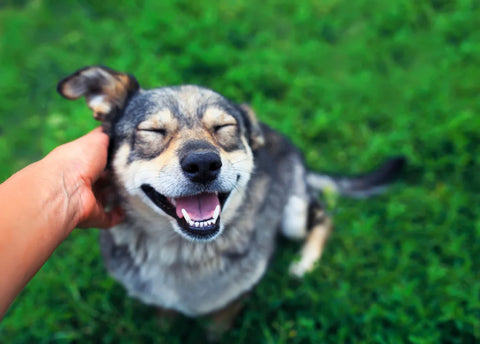

Why is my dog itching & scratching so much? Causes & treatments
Summer is here, and while it means more adventures outdoors, it can also be the peak season for dog itching. If you’ve found yourself wondering, “Why is my dog itching so much?” you’re not alone.
A little scratch behind the ears is normal, but when your dog can’t seem to stop, it may point to something more. In this blog, we’ll guide you through 5 common reasons why your dog may have itchy skin and share some simple ways to help soothe the urge, so your best friend can stay comfortable and happy.
Let’s start at the root of the scratching – the urge to itch. There are lots of reasons why dogs might feel itchy, but in a nutshell, here are 6 well known common causes:
- Fleas, ticks, mites and mange
- Dry or sensitive skin
- Other skin diseases and conditions
- Environmental allergies (Atopy)
- Dietary sensitivities and food allergies
- Psychological Issues
Spotting the signs of an itchy dog
Spotting an itching dog sounds simple – but sometimes it's a bit more complicated than you think. As well as the typical scratch-with-the-hind-leg, dogs respond to itches in other ways. Have a think about the below questions:
- Do they nibble at their skin?
- Do they lick their paws?
- Maybe they rub their face or body on furniture?
- Have they got bald patches?
- Do they get itchy ears often?
So, what’s happening when your dog gets the urge to itch? And how can you help?
Why is your dog itching & scratching?
There are many reasons why your dog has itchy skin, so let’s take a closer look at some of the more common ones, to help you spot what might be going on. Of course, we always recommend speaking to your vet if you are concerned with your pet.
1. Fleas, ticks, and mites
Even the cleanest dogs can pick up fleas and ticks. Ticks and fleas are very common, especially in summertime, as they can thrive in warmer weather. So, so if you’ve forgotten the spot on flea and tick treatment, solving your dog’s scratching could be quick and easy.
So how do you know if your dog has fleas?
- Take a good look around the ears, groin, neck, rump and belly. Look out for raised bumps and signs of scratching (such as redness), or fleas and ticks themselves.
- If you’re not sure if your dog has fleas or not, stand them on a light-coloured sheet and groom them. If you spot some little black specks or spots falling onto the sheet, they may have fleas.
- Pick up some of the spots and put them on damp kitchen paper. If the paper around the spots turns reddish-brown, it’s flea waste.
- If you're not sure, your vet will also be able to help.
In the case of pests, prevention is the best approach. We recommend speaking to your vet and then keeping track of how often you need to reapply anti-flea or tick ointments by setting a calendar reminder. If you have a flea infestation, you’ll need to treat both your dog and your home – here’s our complete guide to fighting fleas.
Other parasites
Ticks can grow large enough to be spotted easily, and it’s essential to remove them as soon as possible to prevent infections. However, it’s vital to remove them very carefully. For further advice, you can read our guidance on how to remove ticks.
If you’re particularly worried or don’t feel confident about removing ticks, always speak to your vet for assistance.
Other itchy pests to watch out for include harvest mites, dust mites, and ear mites. Harvest mites are quite distinctive (they’re a bright orange/red), but when it comes to ear mites or a dust mite problem, you’ll need to pop to the vet for expert diagnosis. Your vet can offer treatment for all mite issues.
Mites also cause mange in dogs. There are two kinds of mange: sarcoptic mange (or ‘canine scabies’), and demodectic mange. Symptoms can include intense itchiness accompanied by scratching, restlessness, hair loss and reddened skin.
Both are caused by mites and call for a trip to the vet for treatment. Typically, this will take the form of medication administered orally, applied topically, or used in a shampoo or dip.
2. Skin issues
Your dog may be scratching because of a skin issue. Here are some of the culprits.
Dry skin
A very common reason dogs scratch, and thankfully, an easy one to spot and soothe! It can due to a lack of skin-supporting omega oils or other important nutrients such as ceramides in their diet, or excessive bathing! It’s usually due to a lack of skin-supporting omega oils in their diet, or excessive bathing.
Spotting dry or sensitive skin in dogs is simple. Look for flakes, redness, and, you guessed it, scratching, as these are the top clues. To soothe dry skin, you can use specially designed dog shampoos, add a dog supplement with Omega-3 and to their food, and make sure you’re feeding a good quality, complete diet.
Skin infections
Skin infections in dogs are pretty common and can range from mild irritation to more serious conditions that require veterinary care. They may be caused by bacteria, fungi, yeast infections, or even virus and can appear anywhere on the body. There can be multiple causes, so veterinary diagnosis is essential to determine the type of infection. Once the cause is addressed, treatment may include topical or oral antibiotics or antifungals, as well as medicated shampoos for bacterial or yeast infections.
Other skin diseases and conditions
Another cause of dog itching can be skin diseases or conditions, such as bacterial or fungal infections, hot spots (also known as moist dermatitis), or contact dermatitis. Hormonal imbalances like Cushing’s disease or hypothyroidism can also affect the skin and can cause some canine itching.

3. Environmental allergies
One of the most common causes of dog itching is environmental factors. Just like people, dogs can get allergies and have sensitive skin. And these dogs are more likely to react to ‘triggers’ – that’s things in their environment like:
- Pollen – yes, dogs can get hayfever too!
- Plants and grasses
- Mould
- Cleaning products like laundry detergent
Contact with these irritants can cause your dog’s skin to become itchy, leading to scratching, nibbling and licking. Prolonged scratching can cause skin damage and hair loss. Some dogs scratch themselves excessively, which can make them uncomfortable and damage their coats. Using a fragrance-free or sensitive laundry detergent for pet bedding might help.
A common sensitivity is pollen. As no one wants to skip walks due to the pollen count, we’ve written a guide on how to identify and help with canine hayfever.
4. Food allergies and dietary sensitivities
Diet is another factor that can cause your dog to develop itchy skin. In addition to an upset stomach, dietary sensitivities can also lead to itchy skin, a dull coat, paw chewing, and even hot spots. Dog food allergies and intolerances can be caused by sensitivities to lots of different ingredients, including:
- Meats like lamb and beef
- Dairy
- Wheat
- Colourings and flavourings
If you suspect your dog may have a dietary sensitivity or food allergy, consult your vet for advice.
5. Psychological Issues
Psychological causes may manifest as itching without obvious skin issues, such as fleas, rashes, or redness, which can be a clue for owners to consider the emotional side of their dog’s well-being.
- Stress and anxiety: Can cause them to lick, chew, or scratch themselves as a self-soothing behaviour.
- Separation anxiety: A dog left alone for long periods can start compulsive scratching or licking, often on the paws or legs.
- Boredom: Without sufficient mental stimulation or exercise, dogs may develop habits such as excessive licking, chewing, or scratching to occupy themselves.
It’s worth noting that a dog may initially scratch for a physical reason (like fleas), but sometimes the behaviour continues long after the fleas are gone, turning into a learned habit.
Remedies for dog itching
There are several reasons why dogs itch. If you’ve eliminated external issues like
fleas, environmental allergies, and skin conditions it is worth speaking to your vet to support you. It could be that your dog may be scratching due to psychological causes, such as boredom, stress, or anxiety, but it’s important to rule out other causes first, as these are more common.
Thankfully, many of the reasons for dog itching are easily treatable, though, if you are unsure, it’s advisable to consult with your veterinarian to identify potential causes for dog scratching.
Medicines can be very helpful (and sometimes essential) in managing itchiness. Alongside these, there are several home remedies you can try, such as vet-approved skin-calming shampoos, nutritional supplements to support skin health, regular grooming and a good-quality, complete diet. Additionally, some dogs develop allergies to grains or some meats so benefit from specific diets.
If you’d like more details about dog itching, you might find our guide to itchy skin in dogs helpful.



